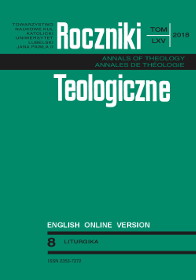Ordination to the Presbyterate in the Syrian Churches: History and Structure of the Rite
Abstrakt
The Sacrament of Holy Orders belongs to one of the most essential mysteries given to us by Jesus Christ. Apostolic succession handed down to the Church is a guarantee of the continuity of tradition and proof of the authenticity of Christian worship focused on the continuously present Lord. Even if liturgical functions are common to the Church as a whole, different liturgical traditions elaborated their own understanding of the sacrament and related ministry. This paper is a reflection on the essence of the ministry of a presbyter in the liturgical space of the Syrian Churches. The author starts by presenting their understanding of the sacrament and its validity and next discusses the structure of the rites in both West and East Syrian traditions. The last part of the presentation contains a theological reflection concerning the main consecratory prayer of Ordination to the Presbyterate.
Bibliografia
Abdišō. “Marganitha IV, 2.” In The Book of Marganitha (The Pearl), On the Truth of Christianity: Written by Mar O’Dishoo Metropolitan of Suwa (Nisibin) and Armenia. Trichur: Mar Themotheus Memorial Printing & Publishing, 1965.
Al Shabi, Felix. Does the Assyrian Church of the East (ACOE) Understand the Sacrament of Holy Orders?, http://www.kaldaya.net/2010/Articles/11_November_2010/43_Nov27_FrFelixShabniEnglish.html (accessed: 2.01.2018).
Andrious, Tawer. Die Sakramente der Kirche des Ostens (Ostsyrische Kirche) im theologische-historischen Rahmen (Magisterarbeit–Universität Wien). Wien: Universität Wien, 2010.
Botte, Bernard. “La formule d’ordination ‘la grace divine’.” L’OrientSyrien 2 (1957): 285–296.
Bradshaw, Paul F. Rites of Ordination. Their History and Theology. Collegeville: Liturgical Press, 2013.
Bradshaw, Paul F. Ordination Rites of the Ancient Churches of the East and West. New York: Pueblo Publishing Company, 1990.
Dalmais, Irénée Henri. “Les ordinations dans la tradition syro-antiochienne.” In Ordinations et ministères. Conférences Saint-Serge XLII semaine d’études liturgiques, edited by Alessandro Pistoia, (series: BEL Subsidia, 85), 97–106. Rome: CVL, Edizioni Liturgiche, 1996.
De Vries, Wilhelm. Sakramenten theologie bei den Nestorianern, (series: Orientalia Christiana analecta, 133). Rome: Pontificum Institutum Orientalium Studiorum, 1947.
Denzinger, Heinrich. Ritus Orientalium Coptorum, Syrorum et Armenorum in administrandis sacramentis. Wirceburgi [Würzburg]: Typis et sumptibus Stahelianis, 1863.
George, Kondothra M. “Sacrament of Ordination in the Malankara Orthodox-Syrian Church.” In Syriac Dialogue. Sixth Non-Official Consultation on Dialogue within the Syriac Tradition, edited by Peter Hofrichter, Gerhard Wilflinger, 80–87. Vienna: Pro Oriente, 2004.
Gy, Pierre-Marie. “Ancient Ordination Prayers.” Studia liturgica 13 (1979): 70–93.
Hippolytus. Traditio apostolica. SCh 11. Paris: Cerf, 1946.
Ignatios Aphrem I Barṣaum. Geschichte der syrischen Wissenschaften und Literatur. Wiesbaden: Harrassowitz, 2012.
Išō’Yahb III Patriarcha. Liber epistularum, CSCO Syr 64. Parisiis: C. Poussielgue, 1904.
Joannou, Pericles. “Chorbishop.” In New Catholic Encyclopedia, vol. III, edited by Berard L. Marthaler, 525–526. Washington: Thomson, 2003.
L’Eucologio Barberini gr. 336, edited by Stefano Parenti, Elena Velkovska. Rome: CLV 20002.
Lazar, Genard. A Response to Cor-Bishop Felix Shabi, http://assyrianpost.blogspot.com/2010/12/response-to-cor-bishop-felix-shabi.html (accessed: 10.10.2017).
Manooramparampil, Thomas. “Holy Orders and Priesthood in the Syro-Malabar Church.” In Syriac Dialogue. Sixth Non-Official Consultation on Dialogue within the Syriac Tradition, edited by Peter Hofrichter, Gerhard Wilflinger, 117–152. Vienna: Pro Oriente, 2004.
Martimort, Aimé Georges. Diaconesses: An Historical Study. San Francisco: Ignatius Press, 1986.
Moffett, Samuel Hugh. A History of Christianity in Asia, vol. I. New York: Orbis Books, 1992.
Nin, Manel. La liturgia dell’Ordine nella tradizione Siro-Occidentale (dispense per gli studenti). Rome: PIO, 2012.
Paprocki, Henryk. “Hipolita Rzymskiego Tradycja Apostolska. Wstęp, przekład, komentarz” [Hippolytus of Rome’s Apostolic Tradition. Introduction, Translation, Commentary]. Studia Theologica Varsaviensia 14, no. 1 (1976): 145–169.
Parenti, Stefano. Gli ordini sacri e i ministeri in Oriente, (series: Scientia Liturgica, vol. IV), 219–229. Casale Monferrato: Piemme, 1998.
Pontificale di Sharfet (Syr., Karsh.). Sharfet: [no publisher] 1952.
Potoczny, Mateusz. “Namaszczenie chorych w liturgiach Kościołów tradycji bizantyjskiej i syryjskiej” [Anointing of the Sick in the Liturgies of the Byzantine and Syrian Church Traditions]. Liturgia Sacra 22, no. 2 (2016): 386–401.
Potoczny, Mateusz. “Saint or Sinner? The Figure of the Priest-Celebrant in the Pre-Anaphoric Prayers of the Liturgy of the West-Syriac Tradition.” Parole de l’Orient 46 (2017): 337–352.
Soro, Bawai. “Priesthood in the Church of the East.” In Syriac Dialogue. Sixth Non-Official Consultation on Dialogue within the Syriac Tradition, edited by Peter Hofrichter, Gerhard Wilflinger, 94–110. Vienna: Pro Oriente 2004.
Stępień, Tomasz. “Hierarchia niebiańska jako wzór idealnej społeczności. Polityczny aspekt myśli Pseudo-Dionizego Areopagity” [The Heavenly Hierarchy as a Model of an Ideal Community. The Political Aspect of the Thoughts of Pseudo-Dionysius the Areopagite]. Warszawskie Studia Teologiczne 27, issue 1 (2014): 161–170.
Taksā d-simidā d-qashishā, Mosul: [no publisher or year].
The Order of the Syro-Malabar Qurbana. Kochi: Syro-Malabar Major Archiepiscopal Commission for Liturgy, 2012.
Winkler, Dietmar W. Ostsyrisches Christentum. Untersuchungen zu Christologie, Ekklesiologie und zu den ökumenischen Beziehungen der Assyrischen Kirche des Ostens. Münster: LIT Verlag, 2003.
Żelazny, Jan W. Zarys literatury patrystycznej kręgu języka syryjskiego [An Outline of the Patristic Literature of the Syrian Language]. Kraków: UNUM 2011.
Copyright (c) 2018 Roczniki Teologiczne

Utwór dostępny jest na licencji Creative Commons Uznanie autorstwa – Użycie niekomercyjne – Bez utworów zależnych 4.0 Międzynarodowe.





